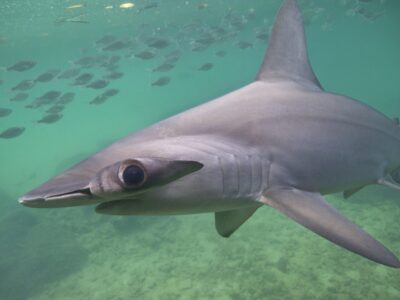Shark may avoid cold blood by holding its breath on deep dives
 A scalloped hammerhead shark (Sphryna lewini) eyeballs the photographer outside the Shark Lab at the Hawai‘i Institute of Marine Biology in Kāneʻohe, Hawai‘i.
Image courtesy of Mark Royer.
A scalloped hammerhead shark (Sphryna lewini) eyeballs the photographer outside the Shark Lab at the Hawai‘i Institute of Marine Biology in Kāneʻohe, Hawai‘i.
Image courtesy of Mark Royer.Scalloped hammerhead sharks (Sphryna lewini) stay warm as they descend into cold, deep water off the coast of Hawai‘i, suggesting the cold-blooded species may maintain its body temperature on dives by holding its breath, according to new research presented at the Ocean Sciences Meeting 2020 in San Diego, California.
The new results are surprising because typically, hammerhead sharks quickly assimilate the temperature of the surrounding water. The sharks are not known to have physiological means to retain or generate heat internally, according to Mark Royer, a marine biologist at the Hawai‘i Institute of Marine Biology (HIMB), who presented the new research on Thursday 20 February 2020.
Royer tracked scalloped hammerhead sharks making frequent, short trips 800 meters below the surface. “Hammerheads are a tropical and warm temperate species. When their body temperature gets too low, they lose muscle function, visual acuity, and their metabolism slows down. If a shark gets too cold, it can’t keep itself moving and breathe,” Royer said.
Sharks breathe by pulling oxygen into their blood from ocean water as it rushes into their mouths and out through their gill slits. They have to keep moving forward to avoid drowning. Water contact over the large surface of their gills also quickly cools or warms their blood to the temperature of the water. Royer thinks the scalloped hammerhead sharks may be simply shutting their mouths, or clamping their gills shut, on dives to keep out the water and avoid getting chilled.
Read more about it in the AGU Blogosphere.


